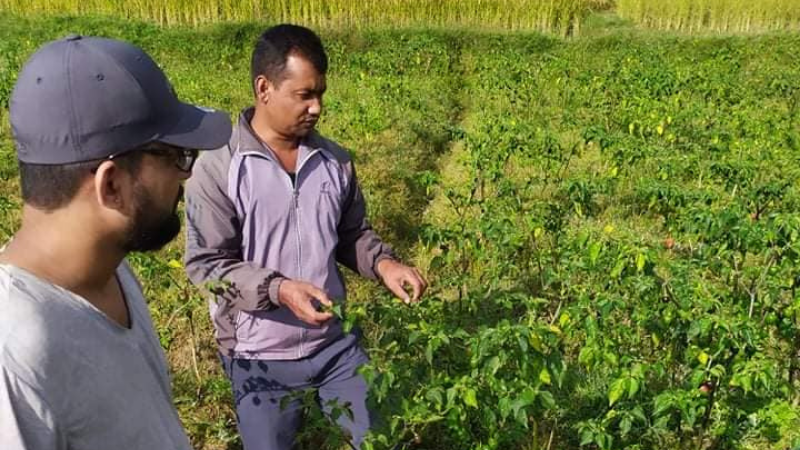by Nepal Agriculture Cooperative Central Federation Ltd. – NACCFL
Description
In the present context, due to the COVID-19, these are the main challenges that farmers in Nepal are facing:
- Due to nationwide lockdown, farmers are unable to get the market for their produce, hence milk and vegetables for example are being dumped.
- Livestock (cows, buffalos, pigs, goats) are lacking enough feed and grass, and the same applies for poultry.
- Due to the lack of proper management of dumped or deceased produce, methane gas emissions increased.
- Farmers are not getting the agro-inputs (seeds, fertilizer, and labour) which will result in low production.
- Besides this, people living in urban areas are not getting the vegetables due to lockdown.
- Farmers are unable to carry out the different intercultural activities in their farmland.
Therefore, the agricultural sector is facing multiple challenges and smallholder farmers involved in these sectors are badly affected.
In this context, NACCFL’s been involved in the marketing of vegetables produced in the rural areas. Before this pandemic, NACCFL had three outlets which were selling only the non-perishable products (pulses, cereals, different flour, honey, butter, fruits etc…). Due to the COVID-19 outbreak, NACCFL has also initiated to market perishable products, such as vegetables, to help its producers find a market.
With the support of its member’s organizations, NACCFL has been selling fresh vegetables from 11 places of Kathmandu valley. Under the slogan “rural products in urban areas”, NACCFL is working in the front line on this activity, according to three procedural steps:
- Collection of demand from customers through email, direct call.
- Packaging as agro-produces as per the demand.
- Home Delivery of agro-produces.
Besides this, the mobile van is travelling to different locations within the Kathmandu valley to market the vegetables. Also, NACCFL is trying to promote C2C (cooperative to cooperative) business, even at the district level – the NACCFL network works at the central level, provincial level, district level and local level. That means that if one cooperative (A) is processing rice, and another cooperative (B) needs rice, NACCFL facilitates/links B with A.
In the framework of the fight against climate change, NACCFL decided to train farmers in organic agriculture, who started farming accordingly, adopting agricultural practices with the aim to mitigate the effects of a changing climate. The action started after testing the soil of numerous smallholder lands, as it has been noticed that the soil was degraded and acidic due to the overuse of fertilizers.
Below some practices implemented:
- Seed treatment: Utilization of organic methods for treatment of seeds such as hot water treatments, disinfectants, herbal treatments, treatments with Trichoderma, usage of salt for rice seeds etc.
- Soil treatment: Application of well-decomposed farm yield manure, vermi-compost, and compost.
- Weed management: Manual or mechanical control of weeds. No use of weedicide on the farm.
- Fertilizer management: Well-decomposed farm yield manure is applied in order to prevent diseases. Organic fertilizers, such as compost, have been used for crops. Different organic fertilizers have been used as per recommended doses. Different types of beneficial microorganisms, such as Trichoderma and rhizobium, have been incorporated in the soil.
- Pesticides and insecticides management: Integrated pest management practices are carried out on the farm. Biopesticides and insecticides have been preferred for the management of pests. Several types of insect traps have been used on the farm. Different beneficial microorganisms like Bacillus thuringiensis, egg parasite Trichogramma, Beauveria bassiana have been used to manage whiteflies, thrips, aphids and weevils. Lecanicillium spp. are deployed against whiteflies, thrips and aphids. Metarhizium spp. are used against pests including beetles, locusts and other grasshoppers, hemiptera, and spider mites. Paecilomyces fumosoroseus is effective against whiteflies, thrips and aphids.
- Diseases control: Beneficial microorganisms such as Bacillus subtilis and Trichoderma viridae are also used to control plant pathogens. Crop rotation, intercropping has also been practised in the field for the control of diseases. Different home-made biofungicides, bio-bactericides have been used to control diseases.
Results
Organic agriculture is taken as one of the appropriate farming systems which has twin objective of climate change mitigation and adaptation. Organic farming mainly depends upon crop rotations, use of crop residues, well-decomposed farm yield manure, mineral rock and bio-fertilizer, natural pesticides and insecticides. Organic agriculture reduces the emission of greenhouse gases, thanks to the avoidance of chemical fertilizers on the farm. Thus, it enhances the carbon content of the soil. Organic farming is also more energy-efficient. It is reported that the use of energy is 20 to 50% less in comparison to the conventional farming system (Pimentel et al., 2005; Schader et al., 2011 and Muller). As organic farming avoids the use of insecticides, pesticides, hormones, etc. it helps in mitigating the climatic change. Organic farming easily sequesters carbon in the soil. (Panwar et al., 2010; IFOAM, 2009).
Climate smartness*
This project is very rich in the use of Climate-Smart agricultural practices. As described in the results of the project, the practices promoted increase the capacity for adaptation, yields and incomes generated by the agricultural systems.
The project also promotes greenhouse gas emission reduction and soil carbon sequestration increase. It is recommended to strengthen farmers’ knowledge in regards to access and use agroclimatic information, to improve the decision-making process such as planting dates, use of varieties, etc. This project can benefit from the inclusion of other practices (some of them in CIAT et al., 2017), which can be identified by the farmers themselves through participatory processes aimed at building capacity.
*This is done in the framework of climate-smart agriculture (CSA) approach. Climate-smartness in agriculture means understanding impacts of climate change and variability along with the agricultural activity, which includes the planning of what crop to plant, when to plant, what variety to plant and what type of management practices are needed to reduce the impact on the environment (e.g. emissions reduction), maintain or increase productivity (e.g. yields) while increasing resilience and improving livelihoods.


